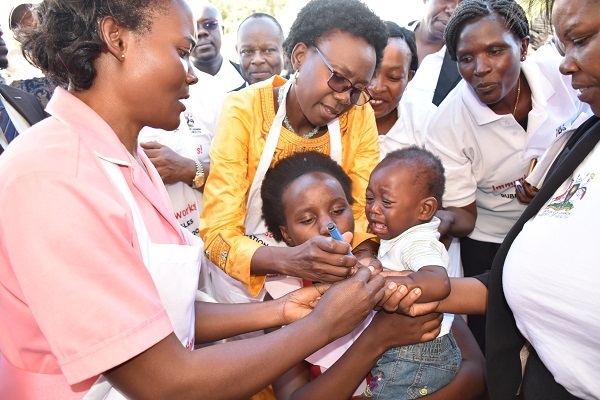
Hexavalent, six-in-one vaccine can reduce spread of the disease and cut costs
ANALYSIS | ESTHER NAKKAZI | Pertussis, or whooping cough, is a preventable disease, yet it still kills more than 150,000 children under five every year – most of them in low- and middle-income countries.
Also known as the 100-day cough, the bacterial infection, which affects the lungs and airways, can last for two to three months or more, making babies and young children extremely unwell.
The spread of this disease could be dramatically reduced with comprehensive coverage of a hexavalent vaccine, which protects children against six different diseases, according to a paper by leading disease specialists.
Combination vaccines can ease the logistics of vaccine management, such as keeping them cool and distributing to all target communities, facilitating higher coverage and preventing future outbreaks.
However, many low- and middle-income countries have struggled to achieve or maintain the high vaccine coverage rates needed to prevent the spread of the disease, according to the paper, which looks at the role of hexavalent vaccines in combating pertussis and polio.
“Most do not offer comprehensive booster vaccination yet, and often have limited surveillance capacity,” the authors write.
Six-in-one
The hexavalent vaccine is a single injection that contains multiple antigens – substances that causes the body’s immune system to produce antibodies against it.
It protects children against six diseases: diphtheria, tetanus, pertussis, hepatitis B, Hib, and polio.
These types of vaccine have become essential for infant immunisation, as the combination reduces the number of injections needed, which increases parental acceptance, lessens adverse effects, and improves adherence to vaccination schedules, say global health experts.
“A hexavalent vaccine protecting against six diseases is wonderful for parents,” says Nicole Guiso-Maclouf, one of the authors of the paper and a former head of research at the biomedical research centre Institut Pasteur.
“Instead of going to the physicians five or six times they will have one shot and that is really easy.”
Kate Hopkins, director of research, vaccine acceptance and demand at the US-based Sabin Vaccine Institute, agrees.
“Hexavalent vaccination provides an opportunity for countries to provide protection against more diseases through a single vaccination series,” says Hopkins, who was not involved in the paper.
She tells SciDev.Net that adopting hexavalent vaccines can improve the efficiency of immunisation programmes and result in significant cost savings.
For healthcare systems, fewer injections reduces time, potential errors, and management complexities, as well as supply costs and wastage.
Unlike pentavalent vaccines, which are widely used in low- and middle-income countries, hexavalent vaccines include protection against polio, avoiding the need for a separate polio vaccine.
This not only streamlines national immunisation programmes, but also supports the global goal of eradicating polio, says Hopkins.
Polio vaccination induces strong, long-lasting immunity, and the disease is close to being eradicated worldwide thanks to widespread vaccination campaigns. However, the continued use of the oral polio vaccine in areas with low coverage has led to outbreaks of vaccine-derived poliovirus.
Maintaining high polio vaccination coverage and using the inactivated polio vaccine in routine immunisation are crucial to prevent resurgence and support global eradication efforts, the authors of the paper say.
Boosters needed
To guard against pertussis, the World Health Organization (WHO) currently recommends an initial three-dose series of vaccines against diphtheria, tetanus, and pertussis, starting at six weeks old, with two subsequent doses four to eight weeks apart. It recommends a booster dose during the second year of life and says there may be a need for further boosters later in life.
However, only 85 countries have all three doses and the booster integrated into their national immunisation programmes, while 44 countries haven’t introduced any of the booster doses, according WHO data.
Pertussis, or whooping cough, once a leading cause of child mortality, remains a significant threat, especially due to waning immunity, low booster uptake, and the high transmissibility of the pathogen, according to the paper.
Since neither infection nor vaccination provides lifelong immunity, pertussis control requires a high level of vaccine-induced protection across all age groups, it says.
High-income countries have achieved coverage rates of around 90 per cent, shifting pertussis burden primarily to infants too young to be vaccinated and older people without booster protection. This has been apparent in recent outbreaks in the UK, Denmark, and Russia.
In low- and middle-income countries, coverage remains inconsistent, and many countries lack comprehensive booster programmes and effective surveillance, leading to significant outbreaks, such as those seen in South Africa, Indonesia, and the Philippines, according to the researchers.
Vaccine surveillance
The hexavalent vaccine is increasingly seen as the “gold standard” for infant vaccination, according to the paper. However, “not all hexavalent vaccines are equal”, says Guiso-Maclouf.
There are important considerations around the two types of formulation of the pertussis part of the vaccine, the researchers highlight. These are known as whole-cell pertussis (wP) and acellular pertussis (aP) vaccines.
According to the researchers, aP vaccines provide more consistent immunity with fewer side effects, and proven efficacy and safety. They argue that this makes them preferable for sustained immunisation rates and equitable health outcomes, contributing to higher completion rates and broader acceptance.
In comparison, wP vaccines are less predictable in composition, causing variable immune responses and adverse effects, from one manufacturer to another and even between batches, the paper says. The possible side effects also pose challenges to schedule adherence, especially in poorer populations, it adds.
In poorer countries, the wP vaccine is most often used, due to its lower production costs. The WHO says the relative efficacy of the best available of the two vaccines are comparable and the adverse affects of both are “relatively minor”.
Guiso-Maclouf says surveillance of the side effects of the reactogencity, or adverse effects, of the vaccines is important, regardless of which type is being used.
“You really need to vaccinate, whatever the vaccine,” she says. “But vaccinate and [carry out] surveillance … not only of the disease, but also surveillance of the reactogenicity of the whole cell vaccine, because some are really reactogenic.”
Guiso-Maclouf urges countries to organize “hospital-based surveillance”, which is less expensive and requires only the infant’s parents or guardians and a paediatrician.
****
Source: scidev.net
 The Independent Uganda: You get the Truth we Pay the Price
The Independent Uganda: You get the Truth we Pay the Price



